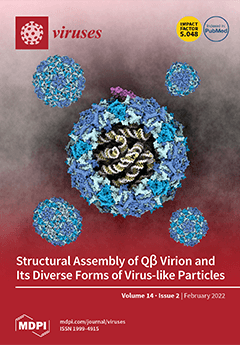Microcystis aeruginosa, as one of the major players in algal bloom, produces microcystins, which are strongly hepatotoxic, endangering human health and damaging the ecological environment. Biological control of the overgrowth of
Microcystis with cyanophage has been proposed to be a promising solution
[...] Read more.
Microcystis aeruginosa, as one of the major players in algal bloom, produces microcystins, which are strongly hepatotoxic, endangering human health and damaging the ecological environment. Biological control of the overgrowth of
Microcystis with cyanophage has been proposed to be a promising solution for algal bloom. In this study, a novel strain of
Microcystis cyanophage, MinS1, was isolated. MinS1 contains an icosahedral head approximately 54 nm in diameter and a 260 nm-long non-contractile tail. The phage genome consists of a linear, double-stranded 49,966 bp DNA molecule, which shares very low homology with known phages in the NCBI database (only 1% of the genome showed weak homology with known phages when analyzed by megablast). The phage contains 75 ORFs, of which 23 ORFs were predicted to code for proteins of known function, 39 ORFs were predicted to code for proteins of unknown function, and 13 ORFs showed no similarity to any protein sequences. Transmission electron microscopy and phylogenetic analysis showed that MinS1 belongs to the family
Siphoviridae. Various experiments confirmed that the phage could infect several different orders of cyanobacteria, including Chroococcales, Nostocales, Oscillatoriales, Hormogonales, and Synechococcales, indicating that it has a very broad host range. In addition, MinS1 has no known antibiotic tolerance genes, virulence genes, and tRNAs, and it is tolerant to temperature, pH, UV, and salinity, suggesting that MinS1 has good potential for application as a biological control agent against cyanobacterial blooms. This study expands the diversity and knowledge of cyanophages, and it provides useful information for the development of novel prevention and control measures against cyanobacterial blooms.
Full article






